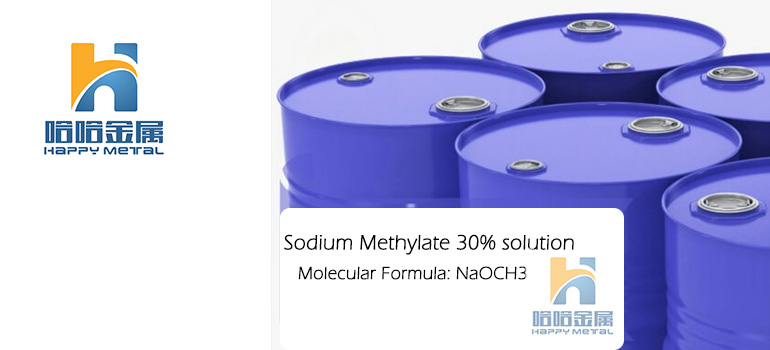Summary:
Comparative Analysis of Sodium Methylate Solution Specifications and Quality
What is Sodium Methylate
Key Specifications of Sodium Methylate Solutions
Quality Factors Affecting Sodium Methylate Solutions
Comparative Analysis of Different Sodium Methylate Solution Specifications
Conclusion and Recommendations for Sodium Methylate Solution Specifications
Sodium methylate is an essential chemical compound widely used in various industries, from pharmaceuticals to biodiesel production. Understanding the specifications of sodium methylate solutions is crucial for ensuring their effective application and safety in handling.
What is Sodium Methylate?
Sodium methylate is a sodium salt of methanol, often encountered as a white, solid substance that dissolves in alcohols and water. It serves as a strong base and a powerful nucleophile, making it valuable for chemical synthesis. Its versatility allows it to play a significant role in reactions such as transesterification, which is vital for producing biodiesel. Additionally, sodium methylate is used in laboratories for various organic reactions, highlighting its importance in both industrial and research settings.
Importance of Specifications in Chemical Solutions
The specifications of sodium methylate solutions include factors such as concentration, purity, and stability. These parameters are critical because they directly influence the performance and safety of the product. For example, a higher concentration may be required for specific applications, but it also necessitates more stringent handling precautions. By adhering to established specifications, manufacturers can ensure consistency and reliability in their products, which is essential for regulatory compliance and customer satisfaction.
Overview of Common Applications
Sodium methylate’s applications are diverse and impactful. In the biodiesel industry, it acts as a catalyst in the transesterification process, converting fats and oils into biodiesel and glycerol. In pharmaceuticals, it’s used in the synthesis of various compounds, playing a key role in developing new medications. Moreover, in the agricultural sector, sodium methylate serves as a reactive agent in pesticide formulation. Understanding these applications helps contextualize the need for stringent specifications, as any deviation can affect product efficacy and safety.
This foundational knowledge about sodium methylate and its specifications sets the stage for a deeper exploration of the factors influencing quality and how different specifications can affect overall performance in various applications.
Key Specifications of Sodium Methylate Solutions
When it comes to sodium methylate solutions, understanding the key specifications is essential for ensuring their effectiveness in various applications. These specifications not only determine the performance of the solution but also influence safety and compliance in industrial settings.
Concentration Levels and Their Impact
The concentration of sodium methylate in a solution is one of the most critical specifications. Typically, sodium methylate is available in various concentrations, ranging from 10% to 30% solutions. Higher concentrations can enhance the reactivity of the solution, making it more suitable for specific applications, such as biodiesel production. However, increased concentration also means greater handling risks, as the solution can be caustic and may cause burns. Therefore, it’s vital to choose the right concentration based on the intended use and to implement appropriate safety measures.
Purity Standards and Testing Methods
Purity is another essential specification for sodium methylate solutions. A high level of purity is crucial, especially in pharmaceutical applications, where impurities can affect product efficacy and safety. Manufacturers often adhere to strict quality control processes, employing various testing methods such as titration and chromatography to ensure the purity of their sodium methylate solutions. Understanding these purity standards helps users gauge the reliability of the product they are using and ensures compliance with industry regulations.
Storage and Handling Requirements
Proper storage and handling of sodium methylate solutions are vital to maintain their quality and safety. These solutions should be stored in a cool, dry place, away from direct sunlight and incompatible materials. Containers must be tightly sealed to prevent moisture absorption, which can affect the solution’s concentration and purity. Additionally, workers handling sodium methylate should wear appropriate personal protective equipment (PPE) to minimize exposure risks. Understanding these requirements is crucial for manufacturers and users alike, as it helps mitigate potential hazards associated with this powerful chemical.
By focusing on these key specifications—concentration levels, purity standards, and storage requirements—users can better appreciate the importance of quality in sodium methylate solutions and make informed decisions in their applications.
Quality Factors Affecting Sodium Methylate Solutions
The quality of sodium methylate solutions is influenced by various factors that can significantly impact their performance and suitability for different applications. Understanding these factors is essential for manufacturers and users to ensure they are working with reliable products.
The Role of Raw Materials
The quality of raw materials used to produce sodium methylate is a critical factor. High-quality methanol and sodium hydroxide are essential for achieving a pure and effective solution. Impurities in these raw materials can lead to contamination in the final product, affecting its reactivity and safety. Manufacturers should source raw materials from reputable suppliers and conduct thorough quality checks to ensure that the starting ingredients meet the necessary specifications.
Production Processes and Their Influence on Quality
The production process for sodium methylate can vary between manufacturers, and this can influence the overall quality of the solution. Techniques such as controlled temperature and pressure during synthesis play a significant role in determining the purity and consistency of the final product. For instance, deviations from optimal production conditions can result in incomplete reactions or the formation of by-products, which can compromise quality. Therefore, adherence to standardized production processes is crucial for maintaining high-quality sodium methylate solutions.
Quality Assurance Practices in Manufacturing
Robust quality assurance practices are essential for ensuring that sodium methylate solutions meet industry standards. This includes regular testing of batches for purity, concentration, and other key specifications. Implementing a comprehensive quality management system allows manufacturers to identify and rectify issues before products reach the market. Additionally, certifications such as ISO can indicate a manufacturer’s commitment to maintaining high-quality standards, providing users with greater confidence in the products they purchase.
By focusing on these quality factors—raw material integrity, production processes, and quality assurance practices—users can better understand what contributes to the reliability and effectiveness of sodium methylate solutions. This knowledge is crucial for making informed decisions in both industrial and laboratory settings.
Comparative Analysis of Different Sodium Methylate Solution Specifications
When selecting a sodium methylate solution for specific applications, it’s essential to compare the various specifications available in the market. Different formulations can have distinct characteristics that affect their performance, safety, and suitability for various uses.
Industry Standards vs. Custom Specifications
Sodium methylate solutions are often produced according to established industry standards, which ensure consistency and reliability. These standards may dictate specific concentrations and purity levels that are widely accepted in the market. However, some manufacturers offer custom specifications tailored to meet unique customer needs. While custom solutions can provide advantages for specific applications, they may also pose risks if they deviate too far from established standards. Users must carefully evaluate the trade-offs between industry-standard solutions and custom formulations to ensure they meet their specific requirements.
Performance Metrics in Various Applications
The effectiveness of sodium methylate solutions can vary significantly based on their specifications. For instance, higher concentration solutions are often preferred in biodiesel production, as they can enhance reaction rates and yield. In contrast, lower concentration solutions may be sufficient for laboratory use, where precise control over reaction conditions is crucial. Evaluating performance metrics such as reaction speed, yield, and stability across different applications helps users determine the most suitable specifications for their intended use.
Cost-Effectiveness and Quality Trade-offs
Cost is a critical consideration when comparing sodium methylate solutions. Higher purity and custom specifications often come at a premium, but they may also offer enhanced performance and safety benefits. Users must assess whether the additional cost is justified by the benefits gained, particularly in large-scale applications where even minor improvements can lead to significant savings. Conducting a thorough cost-benefit analysis, taking into account both the initial purchase price and long-term performance, is essential for making informed decisions.
By examining these aspects—industry standards versus custom specifications, performance metrics, and cost-effectiveness—users can better navigate the complexities of sodium methylate solution selection. This comparative analysis empowers users to choose the right specifications that align with their specific needs, ensuring optimal performance and safety in their applications.
Conclusion and Recommendations for Sodium Methylate Solution Specifications
In summary, sodium methylate solutions play a vital role in various industries, and understanding their specifications is essential for optimizing their use. By considering factors such as concentration, purity, and production processes, users can make informed decisions that enhance both safety and performance.
Best Practices for Selecting Specifications
When choosing sodium methylate solutions, it is crucial to align the specifications with the specific requirements of your application. Start by assessing the intended use—whether for biodiesel production, pharmaceutical synthesis, or laboratory experiments. Based on this assessment, select the appropriate concentration and purity level. Always consult technical data sheets provided by manufacturers to ensure the product meets industry standards. Engaging with suppliers and seeking their expertise can also guide you in selecting the most suitable specifications.
As industries evolve, so too do the demands for chemical solutions like sodium methylate. Increasing emphasis on sustainability and efficiency may drive innovations in production processes, leading to greener manufacturing practices and enhanced formulations. Additionally, as regulatory frameworks tighten, the need for high-purity solutions will likely rise. Staying informed about these trends will help users adapt to changes and maintain compliance with industry standards.
Ultimately, the quality of sodium methylate solutions significantly impacts their performance and safety. Manufacturers should prioritize rigorous quality assurance practices throughout the production process to ensure that their products meet the necessary specifications. Users should remain vigilant, regularly evaluating the quality and performance of the solutions they utilize. By fostering a collaborative relationship with suppliers and staying abreast of industry advancements, both manufacturers and users can contribute to the overall reliability and effectiveness of sodium methylate solutions.
In conclusion, making informed choices about sodium methylate solution specifications not only enhances product performance but also promotes safety and compliance in diverse applications. By following best practices and being aware of future trends, users can optimize their processes and achieve the desired outcomes effectively.




